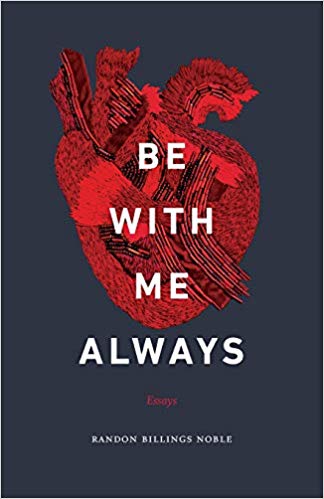
After I miscarried my first pregnancy, I dreamed of former loves, all the ones who came before the one I love now. Night after night, these lost loves returned to me. They were handsome and young. Clothed and naked. Hands shimmered out of darkness. One pushed an empty baby stroller.
Nothing I did could stop the dreams. Grief meant facing a past that haunted me.
Randon Billings Noble’s Be with Me Always took me back to this year of unsettling dreams, to the shadow-lives those dreams invoked, to my own writerly desire to look back, and excise insights I’d missed in real-time. When I finished Be with Me Always, I wanted to begin again, so desperate was I for reassurance that my own hauntings didn’t make me a bad person or unfaithful wife. They made me human. They made me a person who wanted to heal.
The twenty-six essays in Noble’s collection confront hauntings on a personal and literary scale. Famous figures of history and culture interweave with experiences that span Noble’s girlhood to present day. She wrangles with the complexities of love, ambition, identity, rejection, legacy, and parenthood. At heart is the question of who’s doing the haunting? Do we haunt ourselves? Why would we do that?
There’s the mythic first love who comes back –– and comes back –– there’s Dracula and Anne Boleyn and Virginia Woolf. There are women who, to use Woolf’s phrase, “burn like beacons” in our cultural imagination but meet untimely ends because they’re born into patriarchies and born at the wrong time. There’s the specter of abuse that haunts gothic romance, where male desire devours everything.
“I am haunted by my need to be haunted, by my reluctance to let anything stay buried, by my desire to bring hauntedness into this weak winter light and see it for what it truly is,” Noble writes in a list-essay titled “Striking.”
Emily Bronte’s Cathy and Heathcliff trail Noble across the pages of “Striking,” blurring boundaries between the haunted and the haunter. There’s a dreaminess to Be with Me Always that echoes Wuthering Heights, from which Noble draws both epigram and title. Bronte’s novel conflates abuse with love, but Noble’s narrator knows better. Romance does not distort her view of the past.
A first love known as “D” in “Elegy for Dracula” is a looming presence, the proverbial road not taken, a path that beckons and repels. In the figure of Dracula, Noble finds a fitting symbol through which to tell a story about “my dark one,” who smears blood along the spines of her books after she leaves. As with Bronte’s lovers, the monstrous tinges their relationship, and that’s part of the draw. For years, Noble is “still bound” to her D, “still waiting for his call.”
What I love about Be with Me Always is its frankness in confronting myths of “fate” and “meant to be” that enable abuse. Passion, a concept Noble interrogates with exquisite insight in “Elegy for Dracula,” is a dangerous ideal, requiring both suffering and the giving up of power.
“Passion and passive share the same root,” she notes, “and it can be easy to confuse them. I was confused by them. Time after time I gave up action and responsibility for passionate passivity, gliding, restless, into what I thought was fate.”
I wanted to underline, highlight, and circle every single line of the collection’s first essay –– “The Split” –– where Noble recounts moments of clarity that emerge after a motorcycle accident in France. After impact, when she’s splayed in a field, bleeding and searching for a cross pendant, a second self emerges.
This is the same self who tells Noble “You should be thinking of something really important right now” in the moment before impact, and it is the voice that hovers on the edge of consciousness while she awaits rescue. This is a knowing, present voice who both haunts the narrator and promises restoration.
“I could feel her calm and faint disapproval. Not so much disapproval but wisdom,” Noble writes.
The subsequent hauntings of Be with Me Always derive their urgency from this split-self presence. The allure of a haunting is not a hunger for the past, but a hunger for the self who can discern meaning from the past and extract wisdom.
Noble powerfully reminds us that hauntings spring from the same desire that propels enduring essays, the desire to live an examined life.
___
Magin LaSov Gregg lives, writes, and teaches in Frederick, Maryland. Her essays have appeared in Washington Post, Dallas Morning News, Bellingham Review, Rumpus, Full Grown People, Under the Gum Tree, Hippocampus Magazine and elsewhere. She stopped making New Year’s resolutions in 2018, but swears she will finish her first memoir about finding her Jewish faith after moving to the Bible Belt and marrying a Baptist minister.
